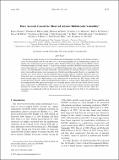| dc.contributor.author | Delworth, Thomas L. | |
| dc.contributor.author | Sutton, Rowan | |
| dc.contributor.author | Hodson, Daniel L. R. | |
| dc.contributor.author | Dixon, Keith W. | |
| dc.contributor.author | Held, Isaac M. | |
| dc.contributor.author | Kushnir, Yochanan | |
| dc.contributor.author | Ming, Yi | |
| dc.contributor.author | Msadek, Rym | |
| dc.contributor.author | Robson, Jon | |
| dc.contributor.author | Rosati, Anthony J. | |
| dc.contributor.author | Ting, MingFang | |
| dc.contributor.author | Vecchi, Gabriel A. | |
| dc.contributor.author | Zhang, Rong, 1971- | |
| dc.contributor.author | Marshall, John C | |
| dc.date.accessioned | 2013-10-03T15:35:55Z | |
| dc.date.available | 2013-10-03T15:35:55Z | |
| dc.date.issued | 2013-04 | |
| dc.date.submitted | 2012-12 | |
| dc.identifier.issn | 0022-4928 | |
| dc.identifier.issn | 1520-0469 | |
| dc.identifier.uri | http://hdl.handle.net/1721.1/81289 | |
| dc.description.abstract | Identifying the prime drivers of the twentieth-century multidecadal variability in the Atlantic Ocean is crucial for predicting how the Atlantic will evolve in the coming decades and the resulting broad impacts on weather and precipitation patterns around the globe. Recently, Booth et al. showed that the Hadley Centre Global Environmental Model, version 2, Earth system configuration (HadGEM2-ES) closely reproduces the observed multidecadal variations of area-averaged North Atlantic sea surface temperature in the twentieth century. The multidecadal variations simulated in HadGEM2-ES are primarily driven by aerosol indirect effects that modify net surface shortwave radiation. On the basis of these results, Booth et al. concluded that aerosols are a prime driver of twentieth-century North Atlantic climate variability. However, here it is shown that there are major discrepancies between the HadGEM2-ES simulations and observations in the North Atlantic upper-ocean heat content, in the spatial pattern of multidecadal SST changes within and outside the North Atlantic, and in the subpolar North Atlantic sea surface salinity. These discrepancies may be strongly influenced by, and indeed in large part caused by, aerosol effects. It is also shown that the aerosol effects simulated in HadGEM2-ES cannot account for the observed anticorrelation between detrended multidecadal surface and subsurface temperature variations in the tropical North Atlantic. These discrepancies cast considerable doubt on the claim that aerosol forcing drives the bulk of this multidecadal variability. | en_US |
| dc.language.iso | en_US | |
| dc.publisher | American Meteorological Society | en_US |
| dc.relation.isversionof | http://dx.doi.org/10.1175/JAS-D-12-0331.1 | en_US |
| dc.rights | Article is made available in accordance with the publisher's policy and may be subject to US copyright law. Please refer to the publisher's site for terms of use. | en_US |
| dc.source | American Meteorological Society | en_US |
| dc.title | Have Aerosols Caused the Observed Atlantic Multidecadal Variability? | en_US |
| dc.type | Article | en_US |
| dc.identifier.citation | Zhang, Rong, Thomas L. Delworth, Rowan Sutton, Daniel L. R. Hodson, Keith W. Dixon, Isaac M. Held, Yochanan Kushnir, et al. “Have Aerosols Caused the Observed Atlantic Multidecadal Variability?” Journal of the Atmospheric Sciences 70, no. 4 (April 2013): 1135-1144. © 2013 American Meteorological Society | en_US |
| dc.contributor.department | Massachusetts Institute of Technology. Department of Earth, Atmospheric, and Planetary Sciences | en_US |
| dc.contributor.mitauthor | Marshall, John C. | en_US |
| dc.relation.journal | Journal of the Atmospheric Sciences | en_US |
| dc.eprint.version | Final published version | en_US |
| dc.type.uri | http://purl.org/eprint/type/JournalArticle | en_US |
| eprint.status | http://purl.org/eprint/status/PeerReviewed | en_US |
| dspace.orderedauthors | Zhang, Rong; Delworth, Thomas L.; Sutton, Rowan; Hodson, Daniel L. R.; Dixon, Keith W.; Held, Isaac M.; Kushnir, Yochanan; Marshall, John; Ming, Yi; Msadek, Rym; Robson, Jon; Rosati, Anthony J.; Ting, MingFang; Vecchi, Gabriel A. | en_US |
| dc.identifier.orcid | https://orcid.org/0000-0001-9230-3591 | |
| mit.license | PUBLISHER_POLICY | en_US |
| mit.metadata.status | Complete | |
